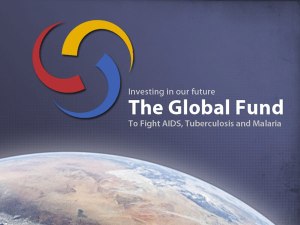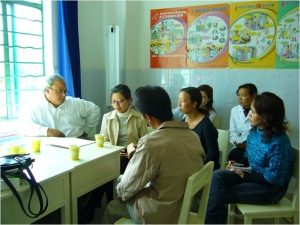My former roommate in Beijing who currently works as an editor/reporter with China.org.cn has done a nice job documenting a recent trip he took to the devastated parts of Sichuan Province. It’s been 3 years since the 8.0 earthquake that killed at least 68,000 people. Some of the pictures of the reconstructed buildings are stunning.
During the past week I participated in Startingbloc’s Boston Institute for Social Innovation. Startingbloc is a nonprofit organization that brings together young, like-minded socially driven thought and business leaders to discuss issues including climate change, CSR, public health and education. I was one of 60-80 individuals selected to be a Fellow this week and this is my reflection on the experience:
Posted in Travels | Leave a Comment »
An interesting progressive model for combating HIV/AIDS has emerged over the past 5-10 years in Vancouver, BC. Once home to the highest rate of HIV infection growth in North America, Vancouver has seen a significant decline in the spread of HIV among its intravenous drug users. The model they’ve implemented encourages drug users to enter a “safe house” called Insite, where individuals are free to use illicit drugs while being supervised by nurses, and are offered treatment if suspected of suffering from HIV. Insite is trying to provide an aggressive and controversial model of reaching and treating a difficult and high-risk population….and so far it appears to be working.
According to one of the center’s studies, financed by the United States National Institutes of Health, from 1996 to 2009 the number of British Columbians taking the medications increased more than sixfold — to 5,413, an estimated 80 percent of those with H.I.V. The number of annual new infections dropped by 52 percent. This happened even as testing increased and syphilis rates kept rising, indicating that people were not switching in droves to condoms or abstinence. (Full Article)
There are two key foundational beliefs to the creation of this model 1) As one nurse put it: “people are going to use drugs whether they have clean needles or they don’t.” 2) A Test and Treat system where all patients regardless of CD4 count are treated if they are HIV+ (aka….don’t prioritize patients, treat everyone, stop the spread).
This first fundamental belief is probably the biggest sticking point for those opposed to the program. Fundamentally while this model may appear to encourage drug use, as the article suggests, many other cities worldwide have already adopted free needle exchange programs as a means of encouraging cleaner and safer drug use.
A 1997 study in The Lancet found that in 29 cities worldwide with needle exchange, H.I.V. infection dropped 6 percent a year among drug injectors, while in 51 cities without, it rose by about 6 percent.
By funding a safe house for users, monitored under the careful watch of medical professionals, Vancouver has taken this belief one step further and is trying to manage dangerous behavior in a contained and safe environment.
In 2009, the site recorded 276,178 visits (an average of 702 visits per day) by 5,447 unique users; 484 overdoses occurred with no fatalities, due to intervention by medical staff. Health Canada has provided $500,000 per year to operate the site, and the BC Ministry of Health contributed $1,200,000 to renovate the site and cover operating costs. (Wikipedia site)
This is of course a difficult pill for public officials to swallow, since such clinics and programs are costly and goes against conservative principals. However, regardless of its implications on drug use, the model undeniably offers a safer environment for drug addicts than they previous had, and should probably get strong consideration in other communities in the developed world where drug use and the spread of HIV is rampant. I’m curious to see how this all shakes out as apparently Canada’s supreme court is reviewing law suits to close down the facility.
Posted in Healthcare | Leave a Comment »
News broke that the Global Fund, a $21.7 billion development fund, and one of the single most important financing source for developmental healthcare, has seen a significant portion of its grants misused due to local corruption. As reported by the AP (full article):
…Much of the money is accounted for with forged documents or improper bookkeeping, indicating it was pocketed, investigators for the Global Fund to Fight AIDS, Tuberculosis and Malaria say. Donated prescription drugs wind up being sold on the black market.…The fund is pulling or suspending grants from nations where corruption is found, and demanding recipients return millions of dollars of misspent money.
Mali – halted grants worth $22.6 million, after the fund’s investigative unit found that $4 million was misappropriated. Half of Mali’s TB and malaria grant money went to supposed “training events,” and signatures were forged on receipts for per diem payments, lodging and travel expense claims. The fund says Mali has arrested 15 people suspected of committing fraud, and its health minister resigned without explanation two days before the audit was made public.
Mauritania – “pervasive fraud,” investigators say, with $4.1 million — 67 percent of an anti-HIV grant — lost to faked documents and other fraud. Similarly, 67 percent of $3.5 million in TB and malaria grant money that investigators examined was eaten up by faked invoices and other requests for payment.
Djibouti – Investigators reviewed more than four-fifths of $20 million in grants, and found about 30 percent of what they examined was lost, unaccounted for or misused. About three-fifths of the almost $5.3 million in misappropriated money went to buy cars, motorcycles and other items without receipts. Almost $750,000 was transferred out of the account with no explanation.
I must say, while this news is discouraging, it’s certainly not shocking. As many in the world of development can attest, developing local partnerships can be a risky process. In a talent and resource constrained environment, organizations like the Global Fund often rush to demonstrate results at the cost of establishing a sound protocol to conduct thorough independent due diligence and review of the work that they are funding. Indeed I think the Global Fund is actually taking a significant positive step in disclosing such alarming figures. While in the short term, this might cause some donors to tighten their wallets (i.e. Sweden) this disclosure will encourage other similar organizations to be more transparent in their efforts to address and finance global healthcare project, and ultimately be viewed with more confidence by donors.
“The messenger is being shot to some extent,” fund spokesman Jon Liden said. “We would contend that we do not have any corruption problems that are significantly different in scale or nature to any other international financing institution.” The fund’s inspector general, John Parsons, said donors should be reassured that the fund is serious about uncovering corruption…”It should be viewed as a comparative advantage to anyone who’s thinking about putting funds in here.
Perhaps this is an optimistic view, but indeed the Global Fund at this point has become so critical to the structure of healthcare development that a panicked reaction to this information is the last thing that’s needed in an already financing constrained environment. The global fund in 2008 represented over 10% of total international funding for HIV/AIDS and presumably plays and even greater role in the fight against Malaria and TB.
And yes, I’m back to blogging after a 2 month hiatus.
Posted in Healthcare | 1 Comment »
Why is China, the world’s fastest growing economy, still receiving more than $2.5 billion a year in foreign government aid (as well as over $1b from the World Bank)? In an article recently published by the AP out of Beijing, a correspondent argues that China shouldn’t be competing with other developing nations for the same pool of money.
BEIJING – China spent tens of billions of dollars on a dazzling 2008 Olympics. It has sent astronauts into space. It recently became the world’s second largest economy. Yet it gets more than $2.5 billion a year in foreign government aid — and taxpayers and lawmakers in donor countries are increasingly asking why.
With the global economic slowdown crimping government budgets, many countries are finding such generosity politically and economically untenable. China says it’s still a developing country in need of aid, while some critics argue that the money should go to poorer countries in Africa and elsewhere.
The current debate spotlights the challenges of addressing poverty in middle-income countries such as China, India and Brazil, where economic growth is strong but wealth is unequally spread. After the U.S., China has the world’s most billionaires, yet incomes averaged just $3,600 last year.
…China is effectively robbing the poor by competing for grants, said Dr. Jack C. Chow, who was the lead U.S. negotiator in talks that set up the Geneva-based Global Fund to Fight AIDS, Tuberculosis and Malaria, a major funder of health programs.
The $1 billion China has been awarded in grants from the fund could have paid for 67 million anti-malarial bed nets, 4.5 million tuberculosis treatments, or nearly 2 million courses of AIDS therapy in poorer countries, Chow said.
“I think the milestone that China is now the second largest economy, arguably, I would say that it’s no longer a developing country with the likes of sub-Saharan Africa,” Chow said in an interview. “Having money from the Global Fund going to China really detracts and depletes that mission of helping people in the poorest of countries.” Full Article
Two points I’d like to make regarding the views expressed in this article:
1) Unlike many other “developing” nations, China’s willingness to accept foreign aid has been a relatively new development – As the article even points out, in the 1970s, during a significantly less stable period of time in China, less than $10M per year of aid was flowing into the country. Therefore, as the country gradually opens its doors to the outside world, it should not be a surprise to see a nation with a significant need for not only outside donations, but also expertise to address deep rooted social issues that the country has little experience dealing with (The article also fails to mention how much of $2.5B per year includes the donations to the 2008 Sichuan Earthquake recovery). China, despite how it is portrayed in the media, has over 700 million people living in the country side (approximately the population of all of Sub-Saharan Africa), many of whom do not have adequate access to healthcare or education. A separate AP correspondent article released earlier this year, in fact highlights that NGOs have flooded into the country to work on social issues and are fearful of the idea that restrictions may be placed on donations. I believe it is simply too soon to be critical of China for competing with countries that are more traditionally viewed as “developing” given that NGOs and foundations view China as a place where their efforts and dollars can go a long way
China has surprised thousands of aid groups by stepping in to regulate overseas donations for the first time, complicating efforts to get money from supporters in the United States and elsewhere. Some groups warned that losing the support could force many to shut down….China has struggled to keep up with the growth of aid groups in recent years. The Ministry of Civil Affairs says about 400,000 groups are registered and many more are not. A report published by the Chinese Academy of Social Sciences has estimated the total number could be 3 million. Full Article
2) The critical tone of the article seems to imply that other countries need the aid more than China since the Chinese government should be able to take care of social issues on their own. However in my work with NGOs in the country, it seems to me that this may be exactly the type of situation many NGOs hope for. During a recent meeting with the Pangaea Global AIDS Foundation which operates in Rwanda, South Africa, and China, I gathered that China programs have been dramatically more successful, largely because of the government’s involvement. While China faces wide ranging social problems from the spread of HIV/AIDS to natural disasters and poor rural education, NGOs are able to partner with a government whose technical expertise and financial war chest offer a significant advantage in addressing these issues. With a stable and supportive partner, NGOs in China are able to quickly establish programs offering strong services and training, setting in place the foundation for what eventually becomes a self-sustaining system. As an example, with the help of NGOs, the Yunnan Province Bureau of Health, has successfully established over 20 clinics, trained hundreds of professionals and served thousands of patients in the last 5 years through a rapid scale up of a soon-to-be a self sustaining HIV/AIDS healthcare system. Many other developing nations cited in the article, while certainly not short of need, lack political stability, and therefore the infrastructure to eventually take on a self-sustaining entity. NGOs and donors have to commit significantly more money to these countries over long periods of time than to a country such as China.
To summarize, I believe the article takes too negative of a tone in suggesting that donations to China detract from donations to other countries. In the global fight against a scourge such as HIV/AIDS, it makes sense that the money goes where it is needed and where it can be put to good use. As long as donations go to building up a previously non-effective health system that saves lives, why should it matter the degree to which a country is categorized as “developing”?
Posted in Healthcare In China | Leave a Comment »





